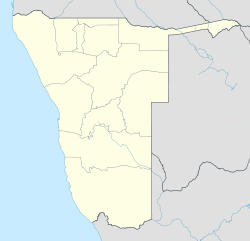- Gross Barmen
-
Gross Barmen
Otjikango (Otjiherero)— recreational area — Location in Namibia Coordinates: 22°6′0″S 16°45′0″E / 22.1°S 16.75°E Country  Namibia
NamibiaRegion Otjozondjupa Region Constituency Okahandja Constituency Founded 1844 Area – Total 0.4 sq mi (0.93 km2) Time zone South African Standard Time (UTC+1) Gross Barmen is a historic settlement and a recreational spa in central Namibia. It is situated on the District Road 1972, 25 km south-east of Okahandja in the Otjozondjupa Region. Its close proximity to the capital Windhoek makes it a popular weekend destination for locals.[1]
Contents
History
Originally known as Otjikango (Otjiherero: "large fountain"), the site was inhabited by the Herero people. When Wesleyan missionaries arrived in Windhoek in 1844 at the invitation of Jonker Afrikaner, Rhenish missionaries Carl Hugo Hahn and Franz Heinrich Kleinschmidt, already resident there since 1842, feared conflict and moved on to Otjikango. Here they established the first Rhenish mission station to the Herero in late 1844.[2] They named the place Barmen[3] after the town Barmen (today part of Wuppertal) in Germany where the headquarters of the Rhenish Missionary Society were located.[4] The ruins of the missionary house are still visible.[1]
At that time the road network in South-West Africa was being developed under the supervision, and at the initiative, of Jonker Afrikaner. Hahn and Kleinschmidt initiated the creation of a path from Windhoek to Barmen via Okahandja, and in 1850 this road, later known as Alter Baiweg (Old Bay Path), was extended via Otjimbingwe to Walvis Bay.[5] This route developed into an important trade connection between the coast and Windhoek and was in use until 1900, when the railway line from Swakopmund was commissioned.[6]
The mission station was operational until the start of Herero War in 1904. The settlement also had a police station at that time.[2]
Hot springs
The recreational centre at Gross Barmen was built in 1977. The water of the hot spring comes from a depth of 2,500 m.[2] It exits the ground at 65°C and is cooled down to around 40°C for the thermal bath.[1]
Gross Barmen is managed by Namibia Wildlife Resorts (NWR), the company responsible for all national parks and official recreational areas in Namibia. Besides the thermal bath it featured a petrol station, a restaurant, and overnight accommodation until 2010 but became the biggest loss maker of NWR. It is now in a period of reconstruction and expansion and is scheduled to be reopened in 2013.[7]
References
- ^ a b c "Gross Barmen Hot Springs". The Cardboard Box. http://www.namibian.org/travel/lodging/barmen.htm. Retrieved 18 February 2011.
- ^ a b c "Gross Barmen Namibia Hot Springs". Namibia 1-on-1. http://www.namibia-1on1.com/grossbarmen.html. Retrieved 21 February 2011.
- ^ Vedder 1997, pp. 215–222.
- ^ Wolf-Dahm, Barbara. "Hahn, Carl. Afrikamissionar und Sprachforscher [Hahn, Carl. Missionary to Africa and Linguist]" (in German). Kulturstiftung der deutschen Vertriebenen, Ostdeutsche Biographie [Cultural Foundation of German Refugees, East–German Biography]. http://www.ostdeutsche-biographie.de/hahnca95.htm. Retrieved 21 February 2011.
- ^ Vedder 1997, pp. 252–253.
- ^ Henckert, Wolfgang (16 March 2006). "Karibib". Henckert Tourist Centre. http://www.henckert.com/karibib/index.php?option=com_content&view=article&id=6%3Akaribib&catid=1%3Ahistory&Itemid=7&lang=en.
- ^ "Hon. Nandi-Ndaitwah unveils Gross Barmen Redevelopment project". Namibia Wildlife Resorts. http://www.nwr.com.na/pdf/gros_barmen_media_release.pdf. Retrieved 21 February 2011.
Literature
- Vedder, Heinrich (1997) (in German). Das alte Südwestafrika. Südwestafrikas Geschichte bis zum Tode Mahareros 1890 [The old South-West Africa. South-West Africa's history until Maharero's death 1890] (7th ed.). Windhoek: Namibia Scientific Society. ISBN 0 949995 33 9.
Categories:- Otjozondjupa Region
- Hot springs of Namibia
Wikimedia Foundation. 2010.

